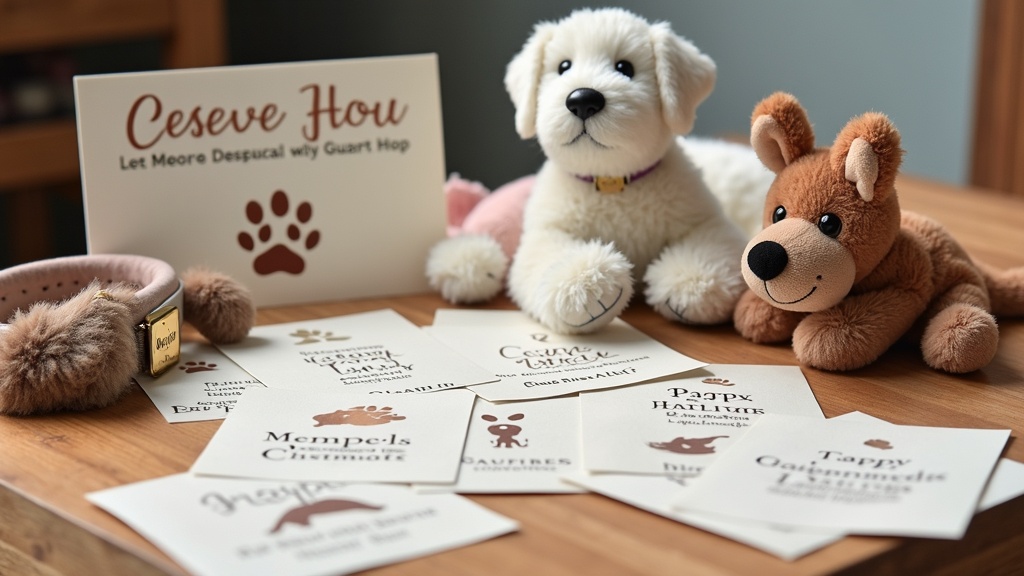Grieving the loss of a beloved pet can feel overwhelming. Sometimes words don’t come easy. Cards for pet bereavement can offer real comfort in these moments, giving you a way to share support, love, and understanding. In this guide, I’ll walk you through how these cards help, what you should think about when picking the right one, and share some thoughtful ideas for personalizing your message for someone going through this difficult experience.

Why Pet Sympathy Cards Matter
When someone loses a pet, it can leave a real hole in their life. Pets are more than companions; they’re family. Receiving a thoughtful card can bring comfort and let the recipient know they aren’t alone in their grief. Even a short note shows that you’re thinking of them and that their loss truly matters. Holding onto a card and reading a few kind words during tough days is surprisingly comforting and can bring gentle moments of relief.
Pet bereavement cards fill a gap when spoken words just aren’t enough. It’s often hard to express yourself in person or you might worry about saying the wrong thing. Cards allow you to show empathy without any pressure, and many people save them as keepsakes for years, returning to them in moments of sadness or reflection.
Types of Cards for Pet Bereavement
There are many types of pet sympathy cards, allowing you to find one that best suits the person and the pet they lost. Some cards have gentle watercolor art or soft photos of animals, pawprints, or natural landscapes, while others use clean, minimalistic designs. The tone can vary—some are hopeful, others are lighthearted, and many stick to a comforting, warm approach. Here are a few types you’ll often find:
- Traditional Sympathy Cards: They feature soft art and heartfelt messages, maintaining a classic, comforting style. These usually work well in most situations.
- Custom Pet Portrait Cards: Some companies will add a photo or illustration of the lost pet, making the card personal and touching.
- Blank Cards: Great if you want to write your own heartfelt message. A blank space means you can make it as personal as you like.
- Spiritual or Rainbow Bridge Cards: These include stories about the “Rainbow Bridge,” providing reassurance by focusing on the idea of seeing pets again someday. This tone can really comfort those who find meaning in such ideas.
- Cards for Kids: With simple wording and gentle images, these cards help younger family members process loss in a gentle, age-appropriate way.
If you want to see some thoughtful options, Wags & Willows has a whole collection of pet sympathy cards worth checking out.
Choosing the Right Pet Bereavement Card
The right card depends on your relationship with the person and the pet. A thoughtful choice can help, and there are a few things to consider when picking one out:
- Your Relationship with the Recipient: If you’re close to the grieving pet owner, something more personal—like custom artwork or photos—can bring comfort. For acquaintances, a simple message or standard design is just right.
- Type of Pet: While many cards feature dogs or cats, there are options for birds, rabbits, and smaller animals. Selecting a card that matches the type of pet adds a considerate touch.
- Adding a Personal Touch: Cards with blank spaces, or those that allow you to include a story or custom portrait, help you craft a unique message. This is perfect for memorializing shared memories or including specific details about the pet.
- Tone: Some people appreciate a gentle, even humorous, approach to break the sadness, while others may respond best to straightforward, warm messages.
Enhancing your card with a small keepsake, like a paw print charm or a pressed flower, will help your message linger in their heart. Mentioning a favorite memory or funny story makes your gesture stand out.
What to Write in a Pet Sympathy Card
Finding the right words can be tough, but it doesn’t need to be complicated. A few simple, heartfelt sentences are often most memorable. Here are some tips to shape your message:
- Personalize your message by mentioning the pet’s name or recalling something specific you remember about them.
- Be genuine; it’s better to be heartfelt and brief than formal and distant.
- Avoid phrases that might diminish their grief, like “it was just a pet.”
- Offer support, letting them know you’re there if they want to talk or simply need company.
You might find these worry-free phrases helpful if you’re lost for words:
- “I’m so sorry about Bella. She was always such a happy spirit, and I know you loved her dearly.”
- “Thinking of you and sending hugs as you remember the special times with Max.”
- “If you need someone to share Toby stories or just some quiet company, I’m here.”
- “Paws may no longer shuffle through our homes, but they sure do leave lasting marks on our hearts.”
Even a simple drawing of a paw print, heart, or flower can help turn a card into a cherished keepsake. If you want your gesture to stand out, you might even consider tucking a favorite pet photo inside the card.
How to Give a Pet Sympathy Card
Handing a card over in person, maybe with a hug or a quiet moment, brings comfort beyond words. If you live far away, mailing your card with a letter is just as meaningful. Consider enclosing a pressed flower, a small pet-related charm, or even a favorite pet photo, if you have one, to add warmth. These extra touches let the recipient know you’re thinking of them, no matter the distance.
For someone grieving deeply, a card in the mail can lift their spirits and remind them that they’re not alone in their sorrow.

Extra Touches: Making a Card Stand Out
For close friends or family, going a little further can mean a lot. Here are some extra ideas to make your card even more memorable:
- Enclose a printed photo of the pet or a small booklet with favorite memories—maybe even invite others to share theirs.
- Write a brief, funny or sweet pet story that will make them smile.
- Include a packet of seeds for planting a flower or small tree in tribute to the pet’s life.
- Add a small pawprint sticker, a meaningful quote, or a magnet that can be placed somewhere special.
Most pet owners truly value these thoughtful extras. They show that the animal left a mark not only on their own life but also on the people around them.
Common Questions About Pet Bereavement Cards
I hear a lot of similar questions about sending these cards. Here are honest answers based on my experience and what others have shared:
Should I send a card if I didn’t really know the pet?
Absolutely. The card is for supporting your loved one or friend. Your gesture, not your connection with the pet, is what matters. Simple words of sympathy go a long way.
Is there a timeline for sending a pet sympathy card?
Sending it soon is best—ideally within a week or so of hearing about the loss. But if you find out later, it’s never too late to let someone know you care about their loss.
I have no idea what to write. Any advice?
You don’t need to say anything complicated. Even “I’m sorry for your loss” or “Thinking of you” is perfectly enough. Sincerity always matters more than length or formality.
Do digital sympathy cards work?
They’re totally fine, especially if getting a physical card isn’t practical. Heartfelt, personal messages make the difference. Some people even print digital cards to keep as a memory.
Wrapping Up
Pet bereavement cards offer a gentle way to lift up someone who’s hurting after a loss. They can’t take away the sadness, but a simple, honest message can be a true comfort and show that you care. Whether you go for a traditional design, custom portrait, or pick a blank card for your own words, taking the time to reach out with kindness always matters.
If you’d like ideas or are looking for cards, feel free to check out these pet sympathy cards from Wags & Willows. Sometimes, just knowing someone else understands makes all the difference when words are tough to find.
**Here’s a little transparency: Our website contains affiliate links. This means if you click and make a purchase, we may receive a small commission. Don’t worry, there’s no extra cost to you. It’s a simple way you can support our mission to bring you quality pet memorial content

Hey a interesting you post you have here!
Pets are really important part of the family and only those with pets know that. Others just can’t relate to the concept of having pets especially if they are not a fan a them. So when they pass away it certainly leaves a great hole in the house, they too are missed and what great way to show your condolences that providing a card for them.
Thanks again and have a great day!
Thank you so much for your kind words — I completely agree with you. Unless someone has truly loved and been loved by a pet, it’s hard to explain the emptiness their absence leaves. They’re family in every way that matters.
Bereavement cards for pet loss can be such a thoughtful gesture. They not only acknowledge the depth of the grief but also remind the person that their bond with their pet is seen and respected. I’ve found that including a heartfelt message or even a memory of the pet can make the card even more meaningful.
Wishing you comfort and joy in the memories of your own pets,
Laura
Paw Print Memorials